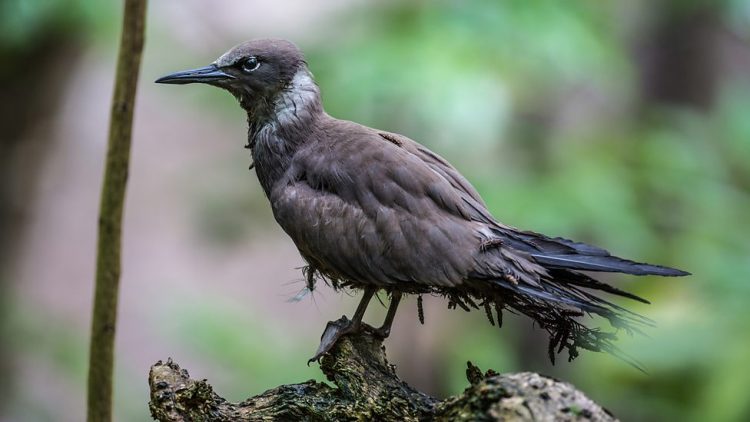“Bird-Catcher Tree” Lures Birds with Free Meals, Then Accidentally Kills Them

Pisonia Brunoniana is a species of small flowering trees native to tropical regions from Hawaii to New Zealand, and as far west as India. The pisonia tree has soft brittle wood with large glossy leaves and a dark secret. If you search among its roots and branches, you’re likely to find thousands of delicate bones […]
How Discarded Orange Peels Brought a Costa Rica Forest Back to Life

20 years ago, a couple of ecologists fighting for the conservation of Costa Rica’s tropical ecosystems convinced a large orange juice producer to donate part of their forestland to a national park in exchange for the right to dispose of massive amounts of orange peels on a degraded plot of land within that same park. […]
Spanish Natural Park Looks Like a Giant Brain from the Air

The San Fernando marshes in Bahía de Cadiz Natural Park, Spain, are sometimes referred to as “Nature’s Brain”, because of their uncanny resemblance to a human brain, when seen from high above. Covering an area of 105 square kilometers, Bahía de Cadiz Natural Park consists of wetlands, beaches, pine forests and reed beds, and has long been a popular […]
Brazilian Man Spends 40 Years Bringing a Forest Back to Life

83-year-old Antonio Vicente has spent the last four decades of his life fighting against the current. As Brazilian landowners cut down rainforests to make room for profitable plantations and cattle grazing grounds, he struggled to bring the lush jungles of his childhood back to life. Today, his efforts are being rewarded, as the completely stripped […]
Couple Spend 25 Years Turning Barren Patch of Land into Paradise of Biodiversity

In 1991, Anil and Pamela Malhotra bought a 55 acres of unused farmland in Karnataka, India, and started planting native trees on it. Over the last 25 years, their small forest has turned into a 300-acre wildlife sanctuary that hundreds of endangered plants, animals and birds call home. Anil and Pamela met and married in New Jersey, […]
Vibrantly Colored Flowers Turn into Creepy Skulls When They Die
The snapdragon or dragon flower is one of the most popular plants in gardens around Europe, United States, and North Africa. Named for its resemblance to a dragon’s mouth that opens and closes when lightly squeezed, this beautiful flower also has a dark side. When its petals wither away and fall off, they leave behind dried […]
The Amazing Story of a Gambler-Turned-Conservationist Who Spent $90 Million Saving Nature
Former gambler and businessman M.C. Davis placed the biggest bet of his life about 20 years ago when he decided to spend a considerable chunk of his fortune on nature. Over the past two decades, he spent $90 million purchasing thousands of acres of land all over Florida. And the risk paid off – he […]
Grieving Mother Dedicates Her Life to Planting Millions of Trees in Memory of Her Son
Meet Yi Jiefeng, a Shanghai woman who has helped plant millions of saplings in Inner Mongolia, over the past 12 years. Her goal is to reforest the arid Alashan Desert while keeping alive the memory of her son who passed away 16 years ago. In the year 2000, Yi’s only son, Yang Ruizhe, was killed in a […]
The Androgynous Lionesses of Botswana
Moremi Game Reserve, located in Botswana’s Okavango Delta, is home to a pride of butch lionesses with deep roars and bushy, luxurious manes. They look so much like male lions, they easily fool competing prides into believing that they’re actually males. The maned lionesses are regularly spotted by visitors to the Mombo Safari Camp, an area […]
Meet Hyperion, the World’s Tallest Tree
Up until August 2006, the tallest known tree in the world was a 369-foot California redwood (Sequoia sempervirens) nicknamed ‘Stratosphere Giant’, located somewhere in the Humboldt Redwoods State Park in California. To give you some idea about its massive size, that’s twice the height of the Statue of Liberty, minus the foundation. But the Giant lost its status […]
These “Walking Trees” in Ecuador Can Allegedly Move Up to 20 Meters per Year
The Socratea exorrhiza is perhaps the world’s only mobile tree. They say its complicated system of roots also serves as legs, helping the tree constantly move towards sunlight as the seasons change. Walking trees can apparently move up to 2-3 cm per day, or 20 meters per year. That may not sound like much, but it’s pretty […]
Iconic “Tree of Life” in Kalaloch Is a Monument to Resilience
Located on an eroded, partially caved in cliff on Kalaloch beach, within Olympic National Park in Washington, the Tree of Life is stubbornly hanging on to the eroding soil with just a few of its roots. Some call it magical, others immortal, I just think it’s resilient. The roots in the middle are exposed and […]
Tiny Bird Mimics Other Birds’ Warning Calls to Confuse Predators
Despite its tiny size, the brown thornbill is quite capable of protecting itself in the wild. Its survival strategy is simple yet effective – it scares other birds away by ‘crying hawk’! It seems that most birds use certain calls to warn their kin of impending danger, especially when hawks and other birds of prey are […]
Abandoned Chinese Village Reclaimed by Nature Becomes Tourist Attraction
It really doesn’t take long for Mother Nature to reclaim her territory, slowly obliterating all signs of human occupation, if we only allow it. Case in point is the abandoned Chinese village of Houtou Wan which, within a span of 50 years, has become a beautiful secret garden completely covered in lush vegetation. Houtou Wan village […]
Moss Viewing – A Strange Yet Increasingly Popular Japanese Pastime
A lot of people walk by moss all the time, without even giving the time of day, but in Japan, they actually have this thing call moss viewing that involves going on trips to damp places and staring at moss for hours, as a means of relaxation. According to Takeshi Ueno, a plant ecology expert at […]
